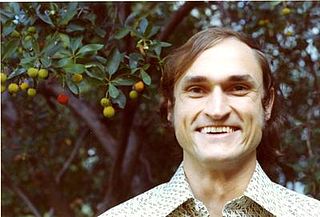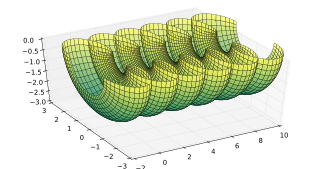
In algebraic geometry, a Calabi–Yau manifold, also known as a Calabi–Yau space, is a particular type of manifold which has properties, such as Ricci flatness, yielding applications in theoretical physics. Particularly in superstring theory, the extra dimensions of spacetime are sometimes conjectured to take the form of a 6-dimensional Calabi–Yau manifold, which led to the idea of mirror symmetry. Their name was coined by Candelas et al. (1985), after Eugenio Calabi who first conjectured that such surfaces might exist, and Shing-Tung Yau (1978) who proved the Calabi conjecture.

Riemannian geometry is the branch of differential geometry that studies Riemannian manifolds, smooth manifolds with a Riemannian metric, i.e. with an inner product on the tangent space at each point that varies smoothly from point to point. This gives, in particular, local notions of angle, length of curves, surface area and volume. From those, some other global quantities can be derived by integrating local contributions.
In Riemannian geometry, the sectional curvature is one of the ways to describe the curvature of Riemannian manifolds. The sectional curvature K(σp) depends on a two-dimensional plane σp in the tangent space at a point p of the manifold. It is the Gaussian curvature of the surface which has the plane σp as a tangent plane at p, obtained from geodesics which start at p in the directions of σp. The sectional curvature is a smooth real-valued function on the 2-Grassmannian bundle over the manifold.
In Riemannian geometry, the scalar curvature is the simplest curvature invariant of a Riemannian manifold. To each point on a Riemannian manifold, it assigns a single real number determined by the intrinsic geometry of the manifold near that point. Specifically, the scalar curvature represents the amount by which the volume of a small geodesic ball in a Riemannian manifold deviates from that of the standard ball in Euclidean space. In two dimensions, the scalar curvature is twice the Gaussian curvature, and completely characterizes the curvature of a surface. In more than two dimensions, however, the curvature of Riemannian manifolds involves more than one functionally independent quantity.

Shing-Tung Yau is a Chinese-born naturalized American mathematician. He was awarded the Fields Medal for his mathematical research in 1982. He is currently the William Caspar Graustein Professor of Mathematics at Harvard University.
In mathematics and especially differential geometry, a Kähler manifold is a manifold with three mutually compatible structures: a complex structure, a Riemannian structure, and a symplectic structure. The concept was first studied by Jan Arnoldus Schouten and David van Dantzig in 1930, and then introduced by Erich Kähler in 1933. The terminology has been fixed by André Weil.

In algebraic geometry and theoretical physics, mirror symmetry is a relationship between geometric objects called Calabi–Yau manifolds. The term refers to a situation where two Calabi–Yau manifolds look very different geometrically but are nevertheless equivalent when employed as extra dimensions of string theory.
In algebraic geometry, the Kodaira dimensionκ(X) measures the size of the canonical model of a projective variety X.

Richard Melvin Schoen is an American mathematician known for his work in differential geometry.
Aleksei Vasil'evich Pogorelov, was a Soviet and Ukrainian mathematician. Specialist in the field of convex and differential geometry, geometric PDEs and elastic shells theory, the author of the novel school textbook on geometry and university textbooks on analytical geometry, on differential geometry, and on foundations of geometry.
In mathematics, the Calabi conjecture was a conjecture about the existence of certain "nice" Riemannian metrics on certain complex manifolds, made by Eugenio Calabi and proved by Shing-Tung Yau. Yau received the Fields Medal in 1982 in part for this proof.
In physics and mathematics, the Hadamard dynamical system is a chaotic dynamical system, a type of dynamical billiards. Introduced by Jacques Hadamard in 1898, and studied by Martin Gutzwiller in the 1980s, it is the first dynamical system to be proven chaotic.
In differential geometry, Hilbert's theorem (1901) states that there exists no complete regular surface of constant negative gaussian curvature immersed in . This theorem answers the question for the negative case of which surfaces in can be obtained by isometrically immersing complete manifolds with constant curvature.

In mathematics, the differential geometry of surfaces deals with the differential geometry of smooth surfaces with various additional structures, most often, a Riemannian metric. Surfaces have been extensively studied from various perspectives: extrinsically, relating to their embedding in Euclidean space and intrinsically, reflecting their properties determined solely by the distance within the surface as measured along curves on the surface. One of the fundamental concepts investigated is the Gaussian curvature, first studied in depth by Carl Friedrich Gauss, who showed that curvature was an intrinsic property of a surface, independent of its isometric embedding in Euclidean space.
The Geometry Festival is an annual mathematics conference held in the United States.

Kefeng Liu, is a Chinese mathematician who is known for his contributions to geometric analysis, particularly the geometry, topology and analysis of moduli spaces of Riemann surfaces and Calabi-Yau manifolds. He is a professor of mathematics at University of California, Los Angeles, as well as the Executive Director of the Center of Mathematical Sciences at Zhejiang University.
In mathematics, the Bogomolov–Miyaoka–Yau inequality is the inequality
Tobias Holck Colding is a Danish mathematician working on geometric analysis, and low-dimensional topology.

In differential geometry, constant-mean-curvature (CMC) surfaces are surfaces with constant mean curvature. This includes minimal surfaces as a subset, but typically they are treated as special case.
In differential geometry, a constant scalar curvature Kähler metric , is a Kähler metric on a complex manifold whose scalar curvature is constant. A special case is Kähler-Einstein metric, and a more general case is extremal Kähler metric.

An International Standard Serial Number (ISSN) is an eight-digit serial number used to uniquely identify a serial publication, such as a magazine. The ISSN is especially helpful in distinguishing between serials with the same title. ISSN are used in ordering, cataloging, interlibrary loans, and other practices in connection with serial literature.
Mathematical Reviews is a journal published by the American Mathematical Society (AMS) that contains brief synopses, and in some cases evaluations, of many articles in mathematics, statistics, and theoretical computer science. The AMS also publishes an associated online bibliographic database called MathSciNet which contains an electronic version of Mathematical Reviews and additionally contains citation information for over 3.5 million items as of 2018.

Inventiones Mathematicae is a mathematical journal published monthly by Springer Science+Business Media. It was established in 1966 and is regarded as one of the most prestigious mathematics journals in the world. As of 2016, the managing editors are Helmut Hofer and Jean-Benoît Bost.











